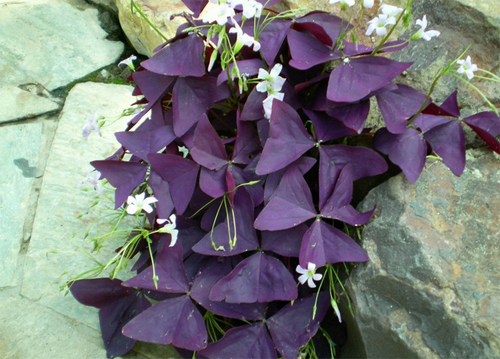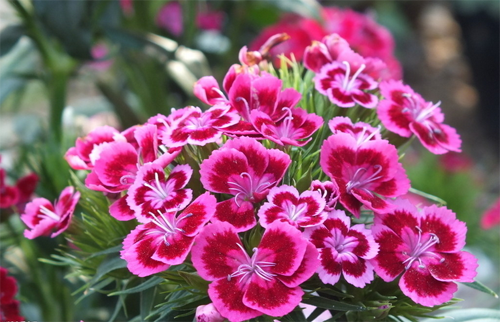What is the nickname of the culture method of carnation flower?
The carnation flower looks like a carnation, and it is a bit silly to distinguish. Because the stem has branches and expands like bamboo in general, the carnation flower has this name. What is the breeding method of the carnation flower? What are the aliases?

The culture method of carnation flower:
Carnation is cold-resistant, drought-resistant, not resistant to heat, poor growth or withering in summer, shade and cooling should be paid attention to during cultivation, which requires sufficient sunshine, dry, ventilation and cool and humid climate.
It likes fertile, loose, good drainage and calcareous loam or sandy loam, avoid waterlogging, good fertilizer, alkali-resistant soil is better.
Carnation blossoms day and night, if the morning sunshine, noon shade, night dew at night, it can prolong the viewing period, and make it continue to branch and blossom.
Its colors are purple, pink, purple, white, red and so on, with a slight aroma, when in full bloom, the black ring in the lower part of the petal is colorful, flashing beautiful velvet light.
1. Watering and ventilation
During the growth period, it should be placed in the sunny, well-ventilated place to maintain, keep the basin soil moist, about every 10 days or so apply mature thin liquid fertilizer; there are too many Rain Water in summer, pay attention to drainage and loosen the soil. Phyllostachys pubescens is easy to cross, and those who keep the seeds should be planted in isolation.
2. Florescence management
Some leaf axillary buds should be removed in time before flowering, mainly to ensure that the top buds bloom. If you want to bloom more, you can pick the heart and make it more branched, you must remove the axillary buds in time to reduce nutrient consumption, and it can blossom again after pruning.
It is advisable to water less in winter. If the temperature is kept at 5: 8 ℃, it can blossom continuously.
3. Nursery period maintenance
When the sowing seedlings grow 1-2 true leaves and grow 3-4 true leaves, they are transplanted. Plant spacing 15 cm, row spacing 20 cm, watering after transplanting.
The suitable temperature for light and temperature growth is 15: 20 ℃. It should be kept indoors in winter and the temperature should be kept above 12 ℃.
The growing period requires sufficient light, placed in a sunny place, and it is appropriate to scatter light in summer to avoid hot sun exposure.
When the temperature is high, it should be shaded and cooled down. Watering and fertilizing watering should be controlled whether it is dry or not. When the height of the plant is 10 cm, it will be transplanted again. The carnation sown in autumn was watered with anti-freezing water from November to December and returned to green water in the spring of the second year. The whole growing period should be topdressing 2: 3 to catch mature human feces, urine or cake fertilizer.
4. Water and fertilizer management
Water thoroughly once, and water it again three days later, depending on the situation. After survival, there is no need to water, do not water other plants together when watering. Often water it when it is dry, keep it hydrated and stop after survival. The temperature is higher in midsummer, the water evaporates quickly during the day, watering is the best in the morning, and the soil is barren and can be applied with some organic fertilizer.
Note:
Don't water too much, it should not be dry, it should not be watered. Carnation blossoms close day and night. If we want to extend the viewing period, we can let it receive sunshine in the morning, shade at noon and dew at night.
Generally speaking, the suitable temperature for the growth of carnation is 15-20 ℃. It should be kept above 12 ℃ in winter and kept in the greenhouse as far as possible.
The alias of carnation flower:
Luoyang flower, Chinese carnation, Luoyang carnation, chrysanthemum, sunset grass, etc., one of the traditional Chinese flowers, is a perennial herb.
Such good-looking carnation flowers are not raised quickly, and it is not difficult to breed them. These flowers can be seen all the year round.
Culture methods of Dianthus chinensis
Flower name: Carnation alias: Genus Caryophyllus of Blue Snow Family
Carnation
Germination conditions (temperature, soil cover, light requirement, etc.): 20-21 ℃
Days required for germination: 4-10 days
Suitable temperature for growth (daily temperature / night temperature): 10-13 ℃
Light demand for growth and other growth conditions: partial shade or partial light
According to the morphological characteristics, the flowers of Celastraceae have low, tufted plants, and the plant height is only 8 2cm. Leaves linear and long sword-shaped, entire, dark green; spring flowering, head terminal. The flower stem is slender and the florets gather at the top of the flower stem. It is semi-spherical and purplish red.
Reproduction and cultivation, the method of plant division is used, and the suitable period is from autumn to winter. The rotten leaf soil rich in organic matter is the best cultivated soil. Drainage and lighting should be good. Sexual warmth is preferred, high temperature and humidity are avoided, and the suitable temperature for growth is 1 5-25 ℃.
Main habits: tufted herbs for many years, 20-30 cm high, leaves lined, pink to rose-red flowers, terminal head-shaped inflorescences, flower stems about 3 cm, sowing or ramet reproduction, sexual preference for sandy soil with adequate sunshine and good drainage, can be used as flower beds, flower borders, rock gardens, cut flowers and potted flowers.
Chinese carnation culture method, alias: Xing'an carnation, northern carnation, carnation, Mongolian carnation, carnation, alpine carnation, Liaodong carnation, long calyx carnation, carnation, forest carnation, carnation, Latin name: Dianthus chinensis L. Caryophyllaceae, Carnation perennial herbs, 30-50 cm high, the whole plant glabrous, with pink green. Stems arising from the root neck, sparsely clustered, erect, upper branches. Leaf blade linear-lanceolate, apex acuminate, base slightly narrow, entire or denticulate, midrib more prominent. Flowers solitary branch tip or several flowers integrated Cymes; purplish red, pink, scarlet or white, apical margin irregularly toothed, throat striped, sparsely bearded; stamens exposed outside throat, anthers blue; ovary oblong, style linear. Capsule cylindric, enclosed in persistent calyx, seeds black, oblate. The flowering period is from May to June and the fruiting period is from July to September.
Culture method: sowing or cutting culture. 1. Sowing and breeding. The seeds were sown in the open field seedbed at the beginning of September. Prepare the land and make high beds one month in advance to prevent flooding. Pour water before sowing. It is appropriate to sow seeds with mixed sand and cover them with fine sandy soil. After sowing, it could germinate in 5 days when the optimum temperature was about 21 ℃, and the seedlings emerged neatly in about 10 days. It was transplanted to Yangqi in late autumn to survive the winter. It can also be direct broadcast in the open field from September to October and transplant in the next spring. It takes about 11 weeks from sowing to seedling. two。 Cuttage culture. From October to March of the following year. Using the branches sprouting from the stem base, the cuttings were cut into long segments of 5-6cm and inserted in the sand bed or open nursery bed. After insertion, shade slightly and maintain the humidity of the air, and then transplant after taking root. It is often used to breed a special variety. Cultivation and management. Chinese carnation has strong growth and easy management. During cultivation, the seedlings were planted in the south at the beginning of November and grew before winter after one transplant, while in the north they were often placed in the sunny bed in November and planted or pots in April of the following year to make them blossom on May Day. The row spacing was 20cm × 40cm at the time of planting. After planting, topdressing was performed every 3 weeks, and coring was carried out for 2 to 3 times to promote multi-branching. Once topdressing before overwintering, the growth is strong. Cut off the residual flowers in time, top dressing once every 2 weeks, and blossom again after September. Due to the inconsistent ripening period of the capsule, attention should be paid to harvesting in batches. Because it is easy to cross between species or varieties of carnation, the parent plants for seed collection should be cultivated in isolation and are not in the same wind direction. The growth at the seedling stage is slow, and the seeds can be sown in advance, so that the plants have already sprouted and branched when the severe winter comes, so as to lay the foundation for the cultivation of large clumps of plants in the following year.
- Prev

How to cultivate Purple Leaf Oxalis? can it be cultured in Water?
Purple leaf sorrel and clover look very similar, and there are many kinds of colors. How can purple leaf sorrel be cultivated? Can only be cultivated in soil, not in water? How to raise purple leaf sorrel: choose basin soil, choose sandy soil with loose and good drainage, the importance of fertility is not too great, of course you want to grow better.
- Next

The propagation method of carnation flower what is the flower language?
Carnation is very good-looking, many people like to raise, want to raise a few more at home, how can this do? What is the breeding method of carnation flower? What is the flower language of Carnation? Sowing and propagation, the optimum temperature for seed germination is 21 to 22 ℃, which is usually carried out in September. Sow seeds in the open field seedbed
Related
- Fuxing push coffee new agricultural production and marketing class: lack of small-scale processing plants
- Jujube rice field leisure farm deep ploughing Yilan for five years to create a space for organic food and play
- Nongyu Farm-A trial of organic papaya for brave women with advanced technology
- Four points for attention in the prevention and control of diseases and insect pests of edible fungi
- How to add nutrient solution to Edible Fungi
- Is there any good way to control edible fungus mites?
- Open Inoculation Technology of Edible Fungi
- Is there any clever way to use fertilizer for edible fungus in winter?
- What agents are used to kill the pathogens of edible fungi in the mushroom shed?
- Rapid drying of Edible Fungi

